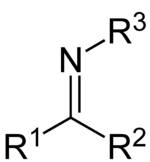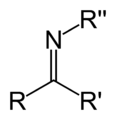Imine

- "Ketimine" redirects here. It should not be confused with "Ketamine"
An imine (/[invalid input: 'icon'][invalid input: 'ɨ']ˈmiːn/ or /ˈɪmɪn/) is a functional group or chemical compound containing a carbon–nitrogen double bond, with the nitrogen attached to a hydrogen atom (H) or an organic group. If this group is not a hydrogen atom, then the compound can sometimes be referred to as a Schiff base.[1] The carbon has two additional single bonds.[2][3][4]
Nomenclature and classification
It is related to ketones and aldehydes by replacement of the oxygen with an NR group. When R = H, the compound is a primary imine, when R is hydrocarbyl, the compound is a secondary imine. Imines exhibit diverse reactivity and are commonly encountered throughout chemistry.[4] When R3 is OH, the imine is called an oxime, and when R3 is NH2 the imine is called a hydrazone.
Aldimines and ketimines
A primary imine in which C is attached to both a hydrocarbyl and a H is called a primary aldimine; a secondary imine with such groups is called a secondary aldimine.[5]
A primary imine in which C is attached to two hydrocarbyls is called a primary ketimine; an imine with such groups is called a secondary ketimine.[6]
-
Primary aldimine
-
Secondary aldimine
-
Primary ketimine
-
Secondary ketimine
Synthesis of imines
Imines are typically prepared by the condensation of primary amines and aldehydes and less commonly ketones. In terms of mechanism, such reactions proceed via the nucleophilic addition giving a hemiaminal -C(OH)(NHR)- intermediate, followed by an elimination of water to yield the imine. (see alkylimino-de-oxo-bisubstitution for a detailed mechanism) The equilibrium in this reaction usually favors of the carbonyl compound and amine, so that azeotropic distillation or use of a dehydrating agent such as molecular sieves is required to push the reaction in favor of imine formation.
Several other methods exist for the synthesis of imines.
- Condensation of carbon acids with nitroso compounds.
- The rearrangement of trityl N-haloamines in the Stieglitz rearrangement.
- Dehydration of hemiaminals.[7]
- By reaction of alkenes with hydrazoic acid in the Schmidt reaction.
- By reaction of a nitrile, hydrochloric acid and an arene in the Hoesch reaction.
- Multicomponent synthesis of 3-thiazolines in the Asinger reaction.
Imine reactions
The most important reactions of imines are their hydrolysis to the corresponding amine and carbonyl compound. Otherwise this functional group participates in many other reactions, many of which are analogous to the reactions of aldehydes and ketones.
- An imine reacts with an amine to an aminal, see for example the synthesis of cucurbituril.
- An imine reacts with dienes in the Aza Diels-Alder reaction to a tetrahydropyridine.
- An imine can be oxidized with meta-chloroperoxybenzoic acid (mCPBA) to give an oxaziridine
- An aromatic imine reacts with an enol ether to a quinoline in the Povarov reaction.
- A tosylimine reacts with an α,β-unsaturated carbonyl compound to an allylic amine in the Aza-Baylis–Hillman reaction.
- Imines are intermediates in the alkylation of amines with formic acid in the Eschweiler-Clarke reaction.
- A rearrangement in carbohydrate chemistry involving an imine is the Amadori rearrangement.
- A methylene transfer reaction of an imine by an unstabilised sulphonium ylide can give an aziridine system.
- An imine is an intermediate in reductive amination.
Acid-base reactions
Somewhat like the parent amines, imines are mildly basic and reversibly protonate to give iminium salts. Iminium derivatives are particularly susceptible to reduction to the amines using transfer hydrogenation or by the stoichiometric action of sodium cyanoborohydride. Since imines derived from unsymmetrical ketones are prochiral, their reduction is a useful method for the synthesis of chiral amines.
As ligands
Imines are common ligands in coordination chemistry. The condensation of salicylaldehyde and acetylacetone give families of imine-containing chelating agents such as salen.
Imine reductions
An imine can be reduced to an amine via hydrogenation for example in a synthesis of m-tolylbenzylamine:[8]
Other reducing agents are lithium aluminium hydride and sodium borohydride.[9]
The first asymmetric imine reduction was reported in 1973 by Kagan using Ph(Me)C=NBn and PhSiH2 in a hydrosilylation with chiral ligand DIOP and rhodium catalyst (RhCl(CH2CH2)2)2.[10] Many systems have since been investigated.[11][12]
Biological role
Imines are common in nature. Vitamin B6 promotes the deamination of amino acids via the formation of imines, for example.
See also
- Enamine
- Schiff base
- Carboximidate
- Oxime
- Other functional groups with a CN double bond: oximes, hydrazones
- Other functional groups with a CN triple bond: nitriles, isonitriles
References
- ^ IUPAC, Compendium of Chemical Terminology, 2nd ed. (the "Gold Book") (1997). Online corrected version: (2006–) "Schiff base". doi:10.1351/goldbook.S05498
- ^ IUPAC, Compendium of Chemical Terminology, 2nd ed. (the "Gold Book") (1997). Online corrected version: (2006–) "imines". doi:10.1351/goldbook.I02957.html[dead link]
- ^ March Jerry; (1985). Advanced Organic Chemistry reactions, mechanisms and structure (3rd ed.). New York: John Wiley & Sons, inc. ISBN 0-471-85472-7
- ^ a b Fletcher, Dermer, Fox, Nomenclature of Organic Compounds (1974) doi:10.1021/ba-1974-0126.ch023
- ^ IUPAC, Compendium of Chemical Terminology, 2nd ed. (the "Gold Book") (1997). Online corrected version: (2006–) "aldimines". doi:10.1351/goldbook.A00209.html
- ^ IUPAC, Compendium of Chemical Terminology, 2nd ed. (the "Gold Book") (1997). Online corrected version: (2006–) "ketimines". doi:10.1351/goldbook.K03381.html
- ^ W. J. Middleton and H. D. Carlson (1988). "Hexafluoroacetone imine". Organic Syntheses; Collected Volumes, vol. 6, p. 664..
- ^ C. F. H. Allen and James VanAllan (1955). "m-Tolylbenzylamine". Organic Syntheses: 827; Collected Volumes, vol. 3.
- ^ For example: Ieva R. Politzer and A. I. Meyers (1988). "Aldehydes from 2-Benzyl-4,4,6-trimethyl-5,6-dihydro-1,3(4H)-oxazine: 1-Phenylcyclopentanecarboxaldehyde". Organic Syntheses; Collected Volumes, vol. 6, p. 905.
- ^ Langlois, N (1973). "Synthese asymetrique d'amines par hydrosilylation d'imines catalysee par un complexe chiral du rhodium". Tet. Lett. 14 (49): 4865. doi:10.1016/S0040-4039(01)87358-5.
- ^ Kobayashi, Shū; Ishitani, Haruro (1999). "Catalytic Enantioselective Addition to Imines". Chem. Rev. 99 (5): 1069. doi:10.1021/cr980414z..
- ^ J. Martens: Reduction of Imino Groups (C=N) in (G. Helmchen, R. W. Hoffmann, J. Mulzer, E. Schaumann) Houben-Weyl Stereoselective Synthesis, Workbench Edition E21 Volume 7, S. 4199-4238, Thieme Verlag Stuttgart, 1996, ISBN 3-13-106124-3.





